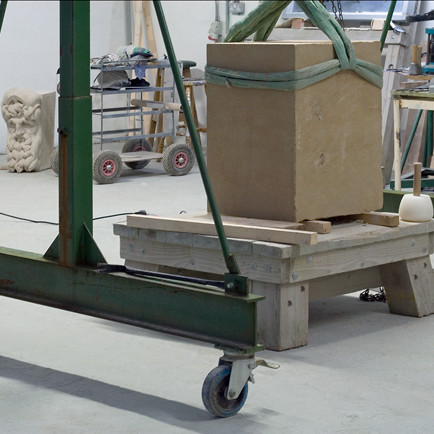Sean Lynch
12 Apr - 08 Jun 2014
SEAN LYNCH
A blow by blow account of stonecarving in Oxford
12 April – 8 June 2014
A blow-by-blow account of stonecarving in Oxford is an installation by Sean Lynch exploring the work of the nineteenth century stone carvers, John and James O’Shea, whose naturalistic renditions of animals and plants are still visible in the architectural detail of buildings in Oxford and Dublin.
Sean Lynch investigates distinctive and often overlooked moments in history that have left fragments of evidence, objects and narratives. He explores these sidelined histories through photographic and sculptural installations, prefabricated or found artefacts and small-scale publications.
The O’Shea brothers had completed a series of notable stone carvings in Dublin during the 1850s before accepting an invitation from the University of Oxford to work on the new Natural History Museum. Controversy quickly surrounded the O’Shea’s carvings of primates on the museum’s façade, as many people interpreted the work as a representation of Darwin’s theory of evolution, a contentious and powerful subject within theological, intellectual and social debates of the time.
Following a quarrel between the O’Sheas’ and the University, James O’Shea attempted a series of impromptu carvings on the entrance to the museum intended to caricature the authorities of Oxford as parrots and owls. These carvings are still visible on the building today.
Lynch activates this story through a variety of objects sited throughout the exhibition. Subtly placed into the shop and café, a collection of material is exhibited about Favorite, a fried chicken outlet now found on what was once the site of Britain’s first public museum, the Ark, in Lambeth, London.
Artefacts from the Pitt Rivers Museum, the Natural History Museum and stone carvings by Dublin-based Stephen Burke each evoke the playfulness of the O’Sheas’ work. In Lynch’s accompanying slide projection, these seemingly unrelated objects come together to weave a narrative about museum culture, public space, individual agency and the construction of history.
A blow by blow account of stonecarving in Oxford
12 April – 8 June 2014
A blow-by-blow account of stonecarving in Oxford is an installation by Sean Lynch exploring the work of the nineteenth century stone carvers, John and James O’Shea, whose naturalistic renditions of animals and plants are still visible in the architectural detail of buildings in Oxford and Dublin.
Sean Lynch investigates distinctive and often overlooked moments in history that have left fragments of evidence, objects and narratives. He explores these sidelined histories through photographic and sculptural installations, prefabricated or found artefacts and small-scale publications.
The O’Shea brothers had completed a series of notable stone carvings in Dublin during the 1850s before accepting an invitation from the University of Oxford to work on the new Natural History Museum. Controversy quickly surrounded the O’Shea’s carvings of primates on the museum’s façade, as many people interpreted the work as a representation of Darwin’s theory of evolution, a contentious and powerful subject within theological, intellectual and social debates of the time.
Following a quarrel between the O’Sheas’ and the University, James O’Shea attempted a series of impromptu carvings on the entrance to the museum intended to caricature the authorities of Oxford as parrots and owls. These carvings are still visible on the building today.
Lynch activates this story through a variety of objects sited throughout the exhibition. Subtly placed into the shop and café, a collection of material is exhibited about Favorite, a fried chicken outlet now found on what was once the site of Britain’s first public museum, the Ark, in Lambeth, London.
Artefacts from the Pitt Rivers Museum, the Natural History Museum and stone carvings by Dublin-based Stephen Burke each evoke the playfulness of the O’Sheas’ work. In Lynch’s accompanying slide projection, these seemingly unrelated objects come together to weave a narrative about museum culture, public space, individual agency and the construction of history.

